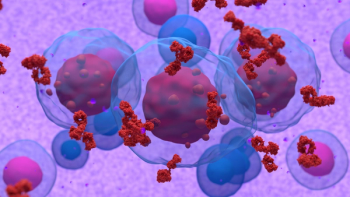
Virtual Reality Helps Patient With Breast Cancer Avoid Mastectomy

A patient with breast cancer and generalized anxiety disorder was able to avoid an unnecessary mastectomy with virtual reality, said Kelly Preti, DNP.
A patient with breast cancer was able to avoid an unnecessary mastectomy through the use of a virtual reality simulation, according to research presented by Kelly Preti, DNP, MBA, AGACNP-BC, OCN, PMGT-BC, at JADPRO Live 2025.
The patient was struggling to adhere to CT simulations and MRIs due to claustrophobia-induced panic attacks and would have had to undergo a mastectomy if she were unable to undergo CT simulation. A multimodal plan was developed by an interdisciplinary team of clinicians working in anesthesia pain service, radiation oncology, and psychiatry.
The patient was given 25 mg of quetiapine the night before and 50 mg of quetiapine 1 hour before the simulation and 2 mg of lorazepam 15 minutes before the simulation. This regimen was paired with a 360-degree virtual reality session involving nature imagery and ambient music.
The plan allowed the patient to undergo CT simulation and, in doing so, avoid a mastectomy that was not aligned with the patient’s or the provider’s goals, as Preti shared in an interview with Oncology Nursing News.
Preti is an adult-gerontology acute care nurse practitioner and advanced practice provider education specialist within Memorial Sloan Kettering Cancer Center’s anesthesia pain service.
Transcript
We’ve been implementing virtual reality in our adult anesthesia pain service and our pediatric day hospital to treat pain and anxiety, and we had a very interesting case that highlights the high impact that virtual reality can have on our patients. A 43-year-old [woman] with breast cancer had been referred to my team after aborting her radiation therapy CT simulation due to panic attacks during the CT simulation.
This patient had a history of generalized anxiety disorder and panic attacks and had received numerous medications of anxiolytics and antidepressants. She had also aborted MRIs in the past for the same reason.
The issue was that if she couldn’t tolerate CT simulation and the subsequent radiation therapy, she would have to get a mastectomy.
It was not the recommended treatment by the oncologist, nor was it the goal of the patient to undergo surgery. We ended up utilizing virtual reality to treat her claustrophobia and anxiety during the session. She successfully tolerated the CT simulation using a distraction application with a nature video of 360-degree views of nature and calming music, in conjunction with her pharmacologic therapy.
After the session, the patient vocalized that she would not have been able to undergo the CT simulation without virtual reality and that the medications alone provided no benefit to her. We were able to help her get through [CT simulation], which prevented any delay in care and any unnecessary surgery or [another] intervention to help get her through the CT simulation.
This transcript has been edited for clarity and conciseness.
Reference
Preti K, Ferraro L, Donoghue P. A case study: using virtual reality to treat anxiety and claustrophobia during radiation therapy simulation—enhancing emotional well-being and preventing unnecessary interventions. Presented at: JADPRO Live 2025; October 23-26, 2025; National Harbor, MD. Abstract JL1301C.
Newsletter
Knowledge is power. Don’t miss the most recent breakthroughs in cancer care.

















































































